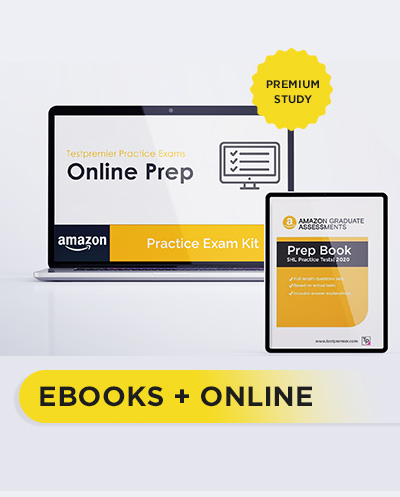About Amazon Aptitude Tests
Amazon aptitude tests, designed by SHL, consist of multiple-choice questions and can last between 60 to 90 minutes. These assessments are designed to evaluate various cognitive abilities and skills that are relevant to the position you’re applying for.
While the specific tests may vary depending on the role and department, there are several common types of aptitude assessments that Amazon may use:
What to Expect from the Amazon Aptitude Assessments
Test Format
The Amazon aptitude test, a 60- to 90-minute online assessment, comprises multiple-choice questions. It may be segmented into five sections:
Question Types
-
Numerical reasoning test: This test assesses your ability to make decisions based on numerical data.
-
Verbal reasoning test: This test evaluates your ability to understand and respond to questions about information provided in a text.
-
Logical reasoning test: This test assesses your ability to analyze patterns in sequences of diagrams.
-
Work style assessment: This test is a personality test that presents you with various statements concerning the way you work, your preferences, what makes you successful in the workplace, and your work values.
-
Work sample simulation assessment: This test asks you to do virtual activities applicable to a certain position.
How to Prepare for the Amazon Aptitude Test
- Research Amazon’s recruitment process and the specific tests they use for the role you’re applying for.
- Practice under timed conditions to simulate the test environment and improve your speed and accuracy.
- Review Amazon’s leadership principles and consider how to demonstrate them in your responses to behavioral assessment questions.
- Use online resources and practice tests from reputable providers to familiarize yourself with the format and types of questions you might encounter.
Amazon Practice Aptitude Test Pack For 2024
Enhance your practice with this updated Amazon Practice Aptitude Test Pack For 2024, featuring all the sections on the actual exams. This book provides insight into what to expect and helps you develop effective study strategies. It contains step-by-step explanations of every question and hints on how to solve them faster.
- Amazon Numerical reasoning test / CEB/Gartner style
- Amazon Verbal reasoning test / CEB/Gartner style
- Amazon Diagrammatic / Logical Reasoning Tests / CEB/Gartner style
Sample Amazon Aptitude Assessment Questions
Numerical Reasoning:
Question 1
A bakery sells 250 loaves of bread per day. If each loaf costs $2.50, how much money does the bakery make in a day?
- $500
- $625
- $750
- $875
Answer: B ($625)
Explanation: To find the total amount of money made in a day, multiply the number of loaves sold (250) by the cost per loaf ($2.50): 250 x $2.50 = $625.
Question 2
A company’s profits increased by 15% in one year. If the profits were $100,000 in the previous year, what were they in the current year?
- $90,000
- $100,000
- $115,000
- $120,000
Answer: C ($115,000)
Explanation: To find the new profit amount, calculate 15% of the original profit ($100,000) and add it to the original profit: $100,000 x 0.15 = $15,000; $100,000 + $15,000 = $115,000.
Question 3:
A company has a profit margin of 20% on its sales. If the sales revenue is $100,000, what is the profit?
- $20,000
- $30,000
- $40,000
- $50,000
Answer: A ($20,000)
Explanation: To find the profit, calculate 20% of the sales revenue ($100,000): $100,000 x 0.20 = $20,000.
Question 4:
A machine can produce 100 units in 5 hours. How many units can it produce in 10 hours?
- 200
- 250
- 300
- 400
Answer: A (200)
Explanation: If the machine produces 100 units in 5 hours, it produces 100/5 = 20 units per hour. In 10 hours, it will produce 20 x 10 = 200 units.
Verbal Reasoning:
Question 1:
Which of the following conclusions can be drawn from the statement: “Most successful entrepreneurs have a strong passion for their work”?
- Having a strong passion for your work is likely to contribute to your success as an entrepreneur.
- Successful entrepreneurs are passionate about their work, but it’s not a guarantee of success.
- Passion has no correlation with success in entrepreneurship.
- Entrepreneurship is only for those who are passionate about their work.
Answer: A (Having a strong passion for your work is likely to contribute to success as an entrepreneur)
Explanation: The statement suggests a correlation between passion and success, implying that having a strong passion for work is a contributing factor to achieving success as an entrepreneur.
Question 2:
Which of the following best summarizes the meaning of the sentence: “The new policy has been met with widespread criticism from employees”?
- The new policy is popular among employees.
- The new policy is unpopular among employees.
- The new policy has been met with mixed reactions from employees.
- The new policy has been met with no reaction from employees.
Answer: B (The new policy is unpopular among employees)
Explanation: The sentence states that the policy has received “widespread criticism,” indicating that many employees are unhappy with the policy, making it unpopular.
Question 3:
Which of the following conclusions can be drawn from the statement: “The new marketing strategy has resulted in a significant increase in sales”?
- The new marketing strategy is effective.
- The new marketing strategy is ineffective.
- The increase in sales is due to other factors.
- The sales have decreased.
Answer: A (The new marketing strategy is effective)
Explanation: The statement directly states that the new marketing strategy has led to an increase in sales, indicating its effectiveness.
Question 4:
Which of the following best summarizes the meaning of the sentence: “The company is facing financial difficulties due to increased competition”?
- The company is performing well despite increased competition.
- The company is facing financial difficulties due to internal issues.
- The company is facing financial difficulties due to increased competition.
- The company is not affected by the increased competition.
Answer: C (The company is facing financial difficulties due to increased competition)
Explanation: The sentence explicitly states that the company’s financial difficulties are caused by increased competition, making this the most accurate summary.
Logical Reasoning:
Question 1: Which of the following sequences comes next? A, C, E, G,?
- H
- I
- J
- K
Answer: B (I)
Explanation: The sequence follows the alphabetical order, with each letter advancing two positions: A (+2) = C, C (+2) = E, E (+2) = G, G (+2) = I.
Question 2:
Which of the following sequences comes next? 2, 5, 8, 11,?
- 14
- 15
- 16
- 17
Answer: A (14)
Explanation: The sequence follows a pattern of adding 3 to the previous term: 2 + 3 = 5, 5 + 3 = 8, 8 + 3 = 11, 11 + 3 = 14.
Handpicked Related Practice Packs
- Airbus Graduate Assessment Practice Questions pack
- BAKER & MCKENZIE Graduate Assessment Practice Questions pack
- British Airways Graduate Assessment Practice Questions pack
- Capgemini Graduate Assessment Practice Questions pack
- CHEVRON Graduate Assessment Practice Questions pack
FAQ
Download from Account: Login to your Testpremier account at www.testpremiercom/my-account
Download from email. Simply open your email Inbox or Promotions folder to download.
If you need further support, email to support @ testpremier.com. We respond as fast as possible.








Hamza Shahid –
The book was very helpful… and the online prep too. Thanks a bunch!